Do the words “poison ivy” make you itch? Not all people are allergic to the oil that’s found throughout this plant, but for those who are and who come into contact with it, the result can be weeks of misery. As a kid I had a bad reaction to poison ivy when I crawled through the undergrowth looking for a lost baseball. Since then I’ve learned to avoid it, and these skills have served me well across many years of blissful, rash-free hikes. Here’s what to look for.
The Overall Shape
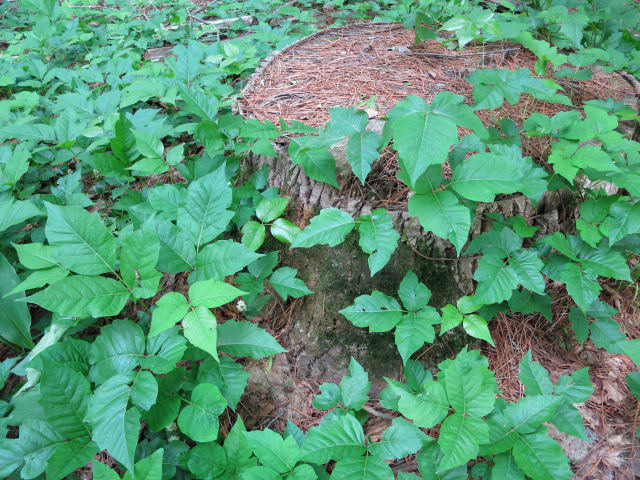
Poison ivy carpets the forest floor.
Poison ivy can take three possible growth forms:
- Sometimes it looks like a thick vine, and you’ll see it winding around a tree and climbing high into the air.
- Sometimes it looks a like a bush or a shrub.
- Other times it will carpet the ground.
As a result, you may see poison ivy at almost any height, from your toes to above your head.
The Leaves
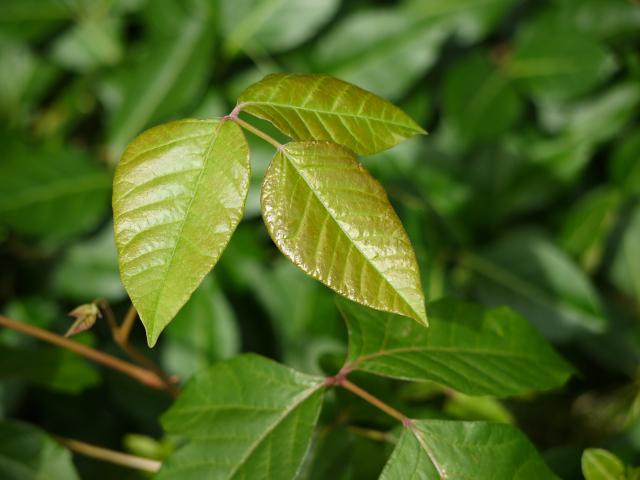
A poison ivy leaf.
Luckily, that familiar rhyme “Leaves of three: let it be” holds true: all of its leaves have three separate leaflets (unless some have been eaten). However, many harmless species also have clusters of three leaflets.
To tell poison ivy apart, look for these features:
- The central leaflet has a longer stalk.
- The edges of the leaflets can be smooth or have a few big jagged “teeth”. Other plants, like some raspberries, may have dozens of small teeth.
- Poison ivy comes in many shades of green, and the leaves can be red when they’re young or during the fall.
The Vines
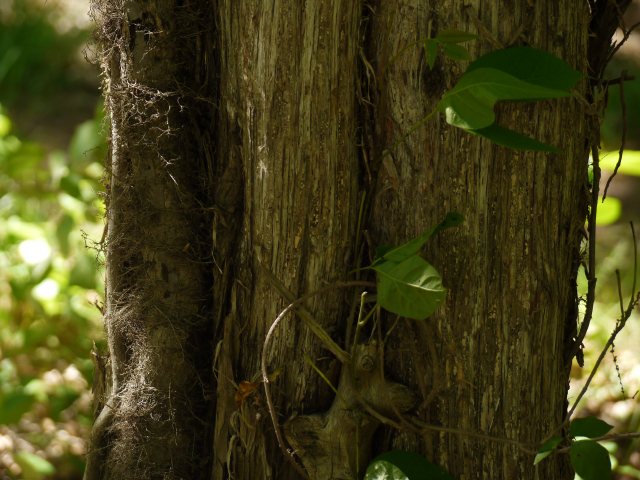
A furry poison ivy vine (at left) climbs a tree.
Even when the leaves die back, the vines can still cause a reaction if touched. Note that poison ivy vines are “hairy”—they’re covered in thin roots that help anchor the plant to the thing it’s climbing. In fact, another one of the many rhymes associated with this plant is “Hairy rope, don’t be a dope.” A few other vines have a hairy appearance, but most of our native vines don’t.
The Berries
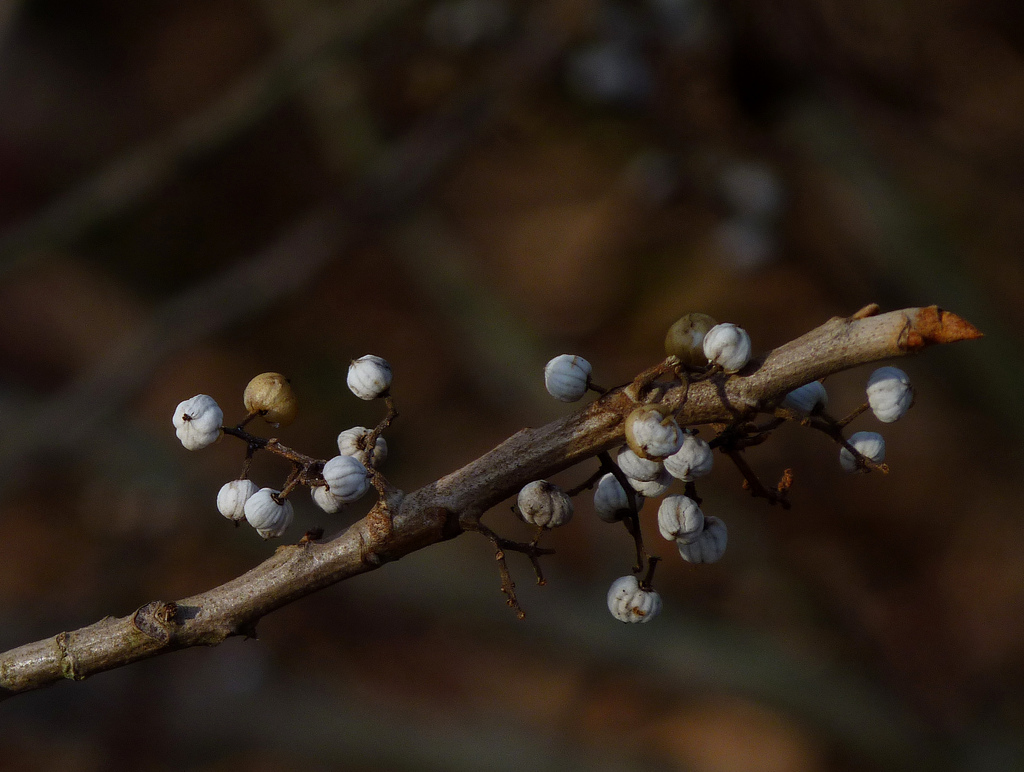
Poison ivy berries. John Beetham, Flickr user Dendroica.
In the summer and fall this plant will grow small clusters of green-white berries. These fruits will often stick around during the winter.
The Softer Side
Even though poison ivy can be a (literal) pain for humans, it’s a boon for other animals. Some creatures, such as cottontails and deer, eat the leaves. Even the goats that live at some of our wildlife sanctuaries enjoy a meal of poison ivy. Because the berries persist through the winter, they give birds a food source when times are tough. Insects pollinate the flowers and chew on the leaves, too.
Poison ivy also has several plant relatives that people find delicious. It’s a member of the Anacardiaceae family, which is also known as the cashew family and includes pistachios and mangoes. In fact, the shell of cashew contains a chemical similar to the one in poison ivy that causes skin irritation.
What To Do If You Touch It
Some people, such as our property managers, have no choice but to touch the plant. You can read about one property manager’s approach at our Wellfleet Bay Wildlife Sanctuary. Here are some quick tips:
- Wash off the irritating oil as soon as you can. Use soap and water or rubbing alcohol, or try specialty products designed for this purpose.
- Clean all items that have touched the plant, including clothes and shoes. The oil found on poison ivy is very stable and can remain for months, if not years, on anything it touches.
- If you get a rash, remember: it’s not contagious. Any new rashes are probably caused by contact with items that still carry the oil.
Do you have any favorite tips for identifying poison ivy?


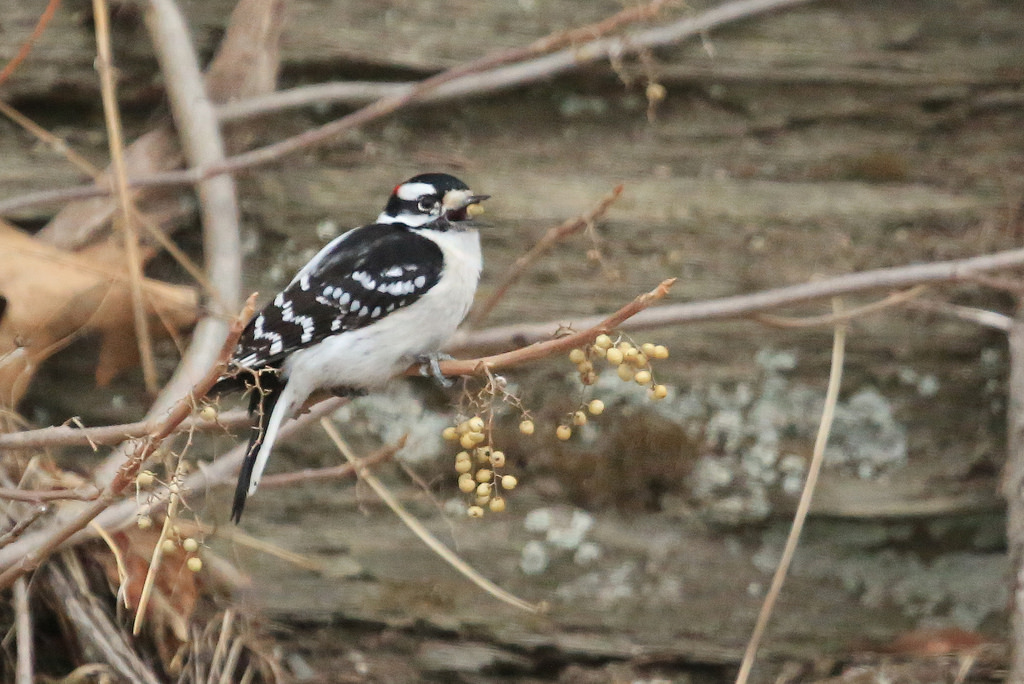
If you contact or even believe that you have contacted it, wash hands, face and rest of body with dish washer detergent. What poison ivey will leave on your skin is oily, and regular soap will just spread the oil to new places on your body. The detergent will dissolve the oil and if applied soon after exposure it will avoid a reaction.
You can also use “Ivy Block” found in the drug store or on line. It is essentially body lotion that repels the oil in poison ivey. Even if you use this, still wash with detergent. You do not need to scrub as you might with a greasy pan, just use this as the initial soap
I was told by my dr that there is no poison ivy in Missouri, only poison oak. Is this true?
Poiosn ivy is found in Missouri, though I’m not sure if it is found in the entire state or just parts of it
Slight variation on the same thing.
By far my favoriate treatment is Isopropyl Alcohol in the 90% range and absorbant, saturated, cloth. Soak a bit then start rubbing. Repeat several times.
No I have both in my back yard area.
A 10x better rhyme than “Hairy rope? Don’t be a dope.” is “Hairy vine? No friend of mine.”
There’s a homeopathic treatment for poison ivy: rhus tox. Works very well. Can get it at most health food stores.
I’ve heard this works but be warned, people react differently this rhus tox. I took it after getting poison ivy and it made it much worse (it actually spread appeared in new areas, like my chest and back)… can’t say I would recommend it after that experience : /
Jewelweed, a plant that sometimes grows near PI is a niracle cure. I had PI. For 5 weeks and still blistering…. I found some jewelweed on a riverbank. Cracked the stem open and applied it to the rash. Then Made a tea from crushed JW, and dabbed in on there as much as I could. In a few days, it was gone. No joke.
Hi Anita – while Poison Ivy does not ever become a tree, its vines and leaves can cover its host tree to such an extent that the tree will appear to be a “poison ivy tree”.
BTW – I really doubt any of the sumac plants you have in your yard are poison sumac, so there is no need to spray them.
I have discovered a bunch of poison Ivy as well as Sumac in my back yard this year. However, I am somewhat confused. Perhaps someone can help me clear this up.
I have sprayed anything I found that was not close to my vegetable garden, with Ivy killer. It seems to be doing the job. Though it has taken some time on some of it.
My confusion is this: I know poison Ivy can grow in a Bush form. If let go and go for many years, could it actually look like a Tree? With branches even? There is a tree on the fence line of my property, near where some of the poison Ivy is that I sprayed. The leaves on this “Tree” look just like that of the poison Ivy I have been killing off. And I noticed today that a lot of the leaves on that tree are yellow.
Feed back pretty, pretty, please!!!
Thanks for this article.
Re this part of it –
“Poison ivy also has several plant relatives that people find delicious. It’s a member of the Anacardiaceae family” –
Sumacs are also members of the Anacardiaceae. All the red-berried Sumac species that grow in Massachusetts (such as Staghorn Sumac and Smooth Sumac) can be used to make a tasty drink very similar in flavor and color to Pink Lemonade. (BTW, the rash-producing Poison Sumac has drooping clusters of greenish-white berries, very similar in appearance to Poison Ivy berries.)
fyi just in case you haven’t already seen this –
Relief in Sight – Scientists Discover Fungus that Attacks Poison Ivy – Could there be a natural solution to this natural nemesis?
http://ens-newswire.com/2014/06/12/scientists-find-killer-fungus-that-attacks-poison-ivy/
Wonderful article. I didn’t realize about the berries and the leaves being eaten by animals and birds. Even poison ivy has some redeeming qualities!
Be sure to wash with cold water, warm or hot opens the pours and causes it to be worse.
I hate poison ivy. get it by looking at it the wrong way